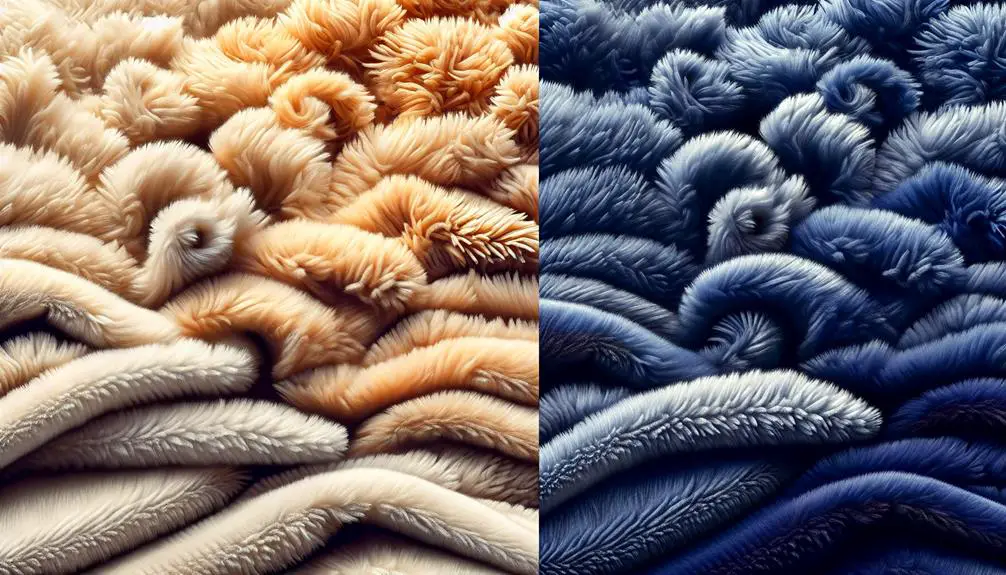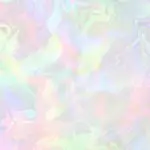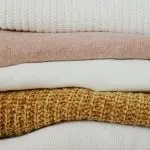As I ran my fingers across the fabric swatches, the differences between chenille and velvet became more apparent. While both offer a luxurious feel, the distinction lies in more than just touch.
Understanding the unique characteristics of each can help you make informed decisions when it comes to selecting the perfect fabric for your furniture or decor. Let's uncover the nuances that set chenille and velvet apart, guiding you towards the ideal choice for your next project.
Table of Contents
Key Takeaways
- Chenille is softer and more durable than velvet, making it a practical choice for cozy settings.
- Velvet exudes luxury and elegance, ideal for formal decor with a rich and opulent feel.
- Chenille offers a wider color range and is easier to maintain, while velvet requires delicate care.
- Chenille suits casual upholstery and blankets, while velvet enhances formal furniture and draperies.
Chenille Vs. Velvet: Overview
When comparing chenille and velvet, it's important to understand their distinct characteristics and how they differ in texture and appearance.
Chenille, known for its softness and depth, is a fabric that adds a cozy and inviting feel to any space. On the other hand, velvet exudes luxury and elegance with its plush and smooth texture, making it a popular choice for sophisticated interior designs.
In the domain of fabric comparison, chenille tends to have a more textured look due to the way it's woven, creating a unique visual appeal that can complement various decor styles. Velvet, with its dense pile and rich sheen, offers a more formal and opulent aesthetic, perfect for adding a touch of glamour to a room.
As interior design trends evolve, both chenille and velvet continue to hold their places as versatile and timeless fabrics that can elevate the look and feel of any space.
Composition Differences
In comparing chenille and velvet, one notable difference lies in their composition. While both fabrics exude luxury and sophistication, understanding their composition can shed light on their unique characteristics.
Here are some key points differentiating the composition of chenille and velvet:
- Chenille:
- Made from cotton, wool, silk, or synthetic fibers
- Achieved by twisting short lengths of yarn around a core material
- Soft and plush texture
- Durable and retains warmth well
- Often used for upholstery and bedding
- Velvet:
- Typically crafted from silk, cotton, or synthetic fibers
- Created by weaving two layers of fabric together and then cutting the threads to create a soft pile
- Luxurious and smooth feel
- Known for its rich sheen and depth of color
- Commonly used in high-end fashion and home decor
Understanding the composition differences between chenille and velvet provides insight into their manufacturing processes and helps in choosing the right fabric for various applications.
Texture and Feel Distinctions
The distinct textures and feels of chenille and velvet play a significant role in setting them apart from each other. Chenille is known for its fabric softness and exceptional tactile appeal. When you run your fingers across chenille fabric, you'll experience a plush, velvety sensation that exudes comfort.
In contrast, velvet boasts a visual richness and luxurious texture that's often associated with elegance and sophistication. Its smooth surface reflects light in a way that creates a subtle sheen, adding to its allure.
While both fabrics offer a sense of luxury, chenille's softness gives it a cozy and inviting feel, perfect for creating a warm and welcoming atmosphere in your space. On the other hand, velvet's opulent texture brings a touch of glamour and extravagance, making it a popular choice for adding a refined touch to home decor or fashion pieces.
Durability and Maintenance Variances
Moving on from their tactile differences, let's now explore how chenille and velvet differ regarding durability and maintenance requirements.
- Durability Comparison: Chenille is typically less durable than velvet due to its construction, which can lead to more wear and tear over time.
- Special Care: Velvet requires delicate handling to maintain its luxurious appearance, while chenille can often withstand more frequent use without significant damage.
- Cleaning Techniques: Velvet may need professional cleaning to avoid crushing the delicate fibers, whereas chenille can often be spot cleaned at home with mild detergent.
- Resistance to Stains: Chenille tends to be more stain-resistant than velvet, making it a practical choice for households with children or pets.
- Sunlight Exposure: Velvet is more prone to fading when exposed to sunlight compared to chenille, requiring more attention to placement and protection from direct UV rays.
Understanding these durability variances and following appropriate maintenance tips can help you make an informed decision when choosing between chenille and velvet for your furniture or decor needs.
Color and Pattern Options
Exploring the diverse array of color and pattern options available for both chenille and velvet can elevate your interior design choices. When it comes to color choices, chenille fabric typically offers a wider range compared to velvet. Chenille's construction allows for a variety of hues to be easily incorporated, making it a versatile option for different color schemes. From bold and vibrant colors to soft pastels or earthy neutrals, chenille can cater to various design preferences.
On the other hand, velvet, with its luxurious sheen, often comes in rich and deep colors that exude elegance and sophistication. While the color options for velvet may not be as extensive as chenille, the fabric's unique texture adds depth and luxury to any space.
When considering pattern variety, both chenille and velvet fabrics offer a plethora of choices, including solid colors, intricate designs, geometric patterns, or even playful prints.
Whether you prefer the plushness of chenille with its broad spectrum of colors or the opulence of velvet with its rich hues and luxurious feel, both fabrics provide ample opportunities to showcase your personal style and enhance your living space.
Ideal Uses and Applications
When choosing between chenille and velvet for decorating, considering their ideal uses and applications is essential. Understanding where each fabric shines can make a significant difference in how your space looks and feels.
Let's break down the best ways to incorporate these luxurious materials into your home decor.
Chenille Vs Velvet
Comparing chenille and velvet reveals their distinct characteristics and diverse ideal uses and applications in the domain of textiles.
- Chenille:
- Known for its softness and fuzzy texture.
- Ideal for cozy blankets and upholstery.
- Offers a casual and comfortable look.
- Great for adding warmth and texture to a room.
- Works well in casual or relaxed settings.
Velvet:
- Luxurious and smooth to the touch.
- Perfect for elegant draperies and formal furniture.
- Adds a touch of sophistication and richness.
- Reflects light beautifully, creating a luxurious ambiance.
- Ideal for formal or upscale decor schemes.
Decorating With Fabrics
Let's now explore how fabrics can transform a space with their unique textures and qualities. Fabric choices play an important role in interior design trends, offering opportunities to enhance a room's ambiance.
When selecting fabrics for decorating, consider the desired mood and functionality of the space. For a cozy and inviting feel, opt for plush velvet upholstery on a statement piece like a sofa or accent chair. Chenille, with its softness and durability, is perfect for curtains or bedding, adding a touch of elegance.
Mixing different textures can create visual interest and depth within a room. Whether you prefer a modern, minimalist look or a more eclectic style, experimenting with fabrics allows you to customize and elevate your living space effortlessly.
Frequently Asked Questions
Can Chenille Be Used for Upholstery in High-Traffic Areas Like Velvet?
Chenille can be used for upholstery in high-traffic areas, but durability compared to velvet might vary. Stain resistance is good with proper care. Cleaning techniques are essential. Chenille offers a wide range of color options.
Are There Any Specific Care Instructions for Maintaining the Texture of Chenille and Velvet?
To keep chenille and velvet looking their best, follow specific care instructions. Regularly vacuum both fabrics to maintain texture. Spot clean spills promptly with gentle cleaners for chenille and dry cleaning for velvet to guarantee durability and appearance longevity.
How Do Chenille and Velvet Compare in Terms of Cost and Availability?
When comparing chenille and velvet, durability-wise, chenille tends to be more resilient. Durability-wise, chenille offers a wider range. Cost-wise, chenille is usually more affordable, while velvet can be pricier and less common.
Are There Any Environmental Considerations to Take Into Account When Choosing Between Chenille and Velvet?
Considering the environmental impact when choosing between chenille and velvet is essential. The production process, material sourcing, and sustainability aspects differ. Chenille may be more sustainable due to its lower impact production process compared to velvet.
Can Chenille and Velvet Be Used Interchangeably in Home Decor Projects?
Yes, chenille and velvet can be used interchangeably in home decor projects. Both fabrics offer excellent durability and are versatile for various decorative applications. The choice between them often depends on personal style preferences and project requirements.
- Tetron Fabric for Marine Applications: Durability and Use Cases - June 18, 2025
- Tetron Fabric for Outdoor Furniture: Weather Resistance and Care - June 18, 2025
- Tetron Fabric for Wall Coverings: Style and Application Tips - June 18, 2025







